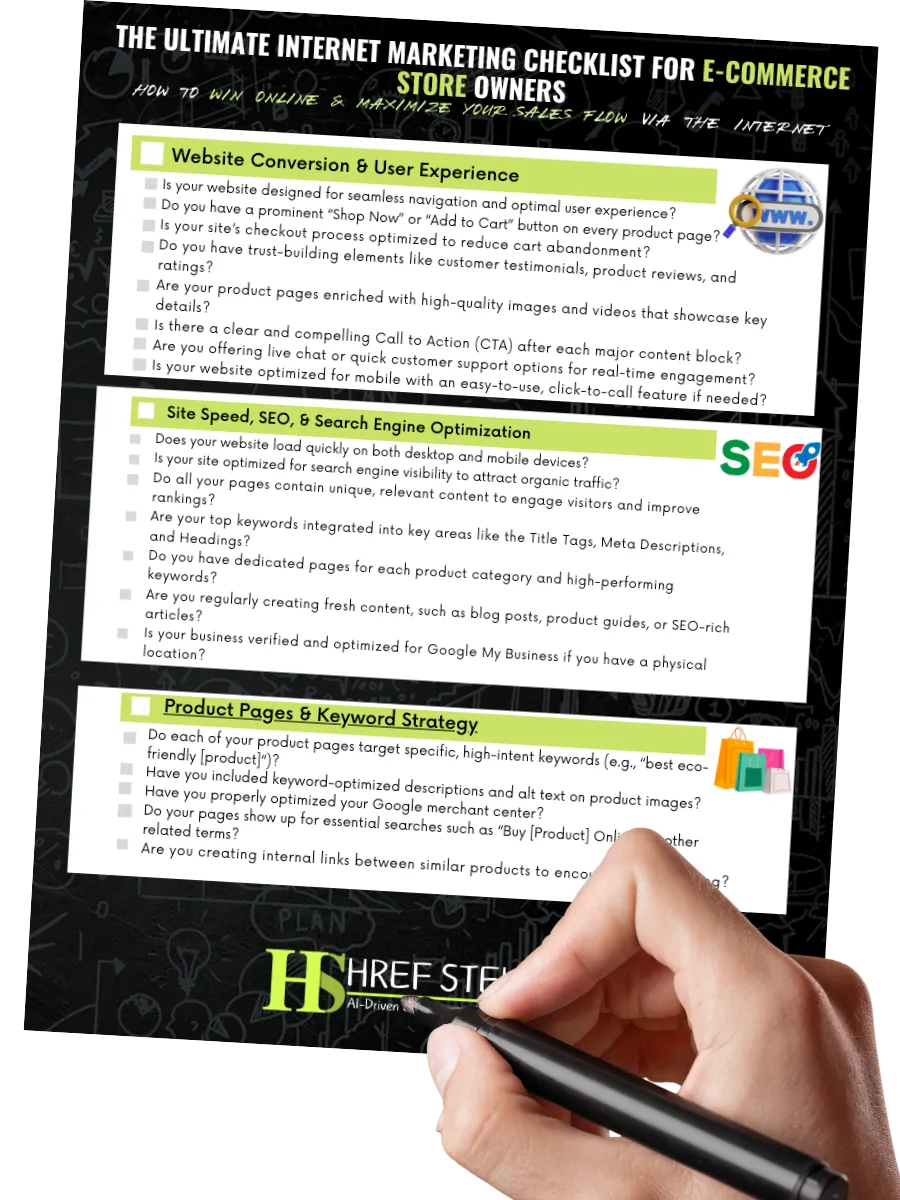Let me ask you a question: Are you building a brand, or just a store?
That one question often separates the successful ecommerce businesses from the thousands of sites that quietly shut down every year.
We all love the idea of launching a sleek online shop, pushing out ads, and watching the orders roll in. But here’s the uncomfortable truth:
| Did you know? More than 80% of ecommerce startups fail within 18 to 24 months |
Why? It’s not because they didn’t have a nice product. It’s because they missed the core needs for successful ecommerce. And often, the mistakes are entirely avoidable, if you know what to watch for. That’s why many successful brands work with the best ecommerce marketing agencies in the USA to avoid those costly pitfalls.
Whether you’re running an online store, about to launch one, or feeling stuck while scaling, here are 10 common reasons eCommerce businesses fail, and how to turn each one into an advantage.
1. Selling Something Nobody Really Needs

Let’s start with the biggest trap. You’re passionate about your product. You’ve spent months developing it, designing a site, planning your launch…
But have you really validated if people want it?
Many ecommerce businesses fail not because they weren’t talented, but because they solved a problem no one had, or a problem no one cared enough to pay for.
Ask yourself:
- What problem does my product solve?
- Who is actively searching for a solution?
- Is this a painkiller or a vitamin?
Pro Tip: Before spending big on inventory or ads, run a landing page with pre-orders or waitlists. If nobody signs up, that’s feedback, not failure.
2. Targeting Everyone and Reaching No One
Here’s the thing- if your store is “for everyone,” it’s actually for no one.
You can’t compete with the reach or budget of giants like Amazon. But what you can do is niche down and speak directly to a specific group of people. That’s where the real magic happens.
Start by asking yourself:
- Who exactly am I trying to reach?
- What are they struggling with?
- How do they talk, search, or shop online?
For example, if you sell yoga gear, are you talking to seasoned instructors? Busy new moms? Or maybe men over 40 dealing with old injuries? Same products, totally different conversations.
When you understand your ideal customer on a deeper level, you’re not just selling, you’re connecting. And that kind of connection is what drives real sales and long-term growth.
3. Weak Brand Positioning

There are countless online stores selling candles, coffee, hoodies, supplements, and planners. So, why should anyone pick yours?
It’s not about being the cheapest or the trendiest. Strong brand positioning means giving people a reason to care, and a reason to choose you over someone else.
Ask yourself:
- What makes your store different?
- Why should someone buy from you instead of another brand selling the same thing?
If you can’t answer that clearly, that’s a red flag.
How to fix it:
- Find your edge – Look at what you’re doing differently—maybe it’s the quality, the story behind your products, your customer service, or the values your brand stands for.
- Put it into one clear sentence – Something like: “We make eco-friendly planners for busy moms who want to stay organized without the guilt of waste.”
- Use that message everywhere – From your homepage headline to optimizing product pages, emails, and social media—your brand promise should be front and center.
People don’t remember generic things. They remember being bold, specific, and honest.
4. Terrible Website UX Is Costing You Sales
When was the last time you tried buying from your own site on your phone? Is it fast? Easy to use? Do you feel safe entering your card info?
If your site is slow, cluttered, or confusing, people will leave, no matter how good your product is.
Here’s how to fix it:
- Design mobile-first
- Keep navigation simple
- Make CTA buttons clear and bold
- Use one-click checkout options
Your website should feel trustworthy and effortless to shop. Don’t treat UX like an afterthought, it directly impacts conversions. People don’t just buy what looks good, they buy what feels easy.
5. Relying on Ads Without Strategy
Here’s the trap a lot of eCommerce stores fall into: you launch a few Meta or Google ads, get some clicks, maybe even a few add-to-carts… but barely any sales.
Why? Because ads alone don’t build a business.
The problem isn’t just the ad, it’s what happens after the click. If your offer isn’t clear, your product page doesn’t convert, or your follow-up game is weak, that money disappears fast.
How to fix it:
- Stop treating ads like a magic button.
- Focus on your full customer journey, what do they see after they click?
- Build trust with reviews, solid product pages, and fast checkout.
- Use retargeting, email, and SMS to bring them back.
Ads bring attention. But without a plan behind them, that attention goes nowhere.
6. No Retention Strategy

If all your focus is on getting new customers, you’re on a treadmill—moving fast but going nowhere.
Customer acquisition costs keep rising. But returning customers? They’re cheaper, more loyal, and spend more over time.
So ask yourself: what happens after the first sale?
If it’s silence, here’s how to fix it:
- Send post-purchase emails (thank-yous, product tips, review requests)
- Offer loyalty rewards or referral perks
- Set up replenishment reminders (great for consumables)
- Use their purchase data to send personalized offers
- Give VIPs early access, sneak peeks, or private sales
Your past buyers are your biggest growth lever. Treat them like they matter, and they’ll keep coming back.
7. Poor Inventory and Fulfillment Planning

We’ve all seen it, a small Shopify store goes viral on TikTok, orders pour in… and then everything falls apart. Why? Because the backend couldn’t keep up.
As an eCommerce owner, your operations have to scale with your growth. If they don’t, you’re setting yourself up for angry customers, refund requests, and a reputation you’ll spend months fixing.
Here’s how to avoid the chaos:
- Use proper inventory management tools (and sync across platforms)
- If you’re not shipping in-house, partner with a reliable 3PL
- Plan for demand spikes, sales, holidays, influencer promos, etc.
- Be upfront about shipping times on your product pages
Great marketing gets you orders. Great operations turn those orders into happy, returning customers.
At the end of the day, your logistics aren’t just behind-the-scenes, they are your brand.
8. No Understanding of Financials
Do you know your net profit, or are you just watching revenue roll in?
You’re not alone. A lot of ecommerce founders focus on top-line sales but ignore the numbers that actually matter.
If you’re not tracking:
- CAC (Customer Acquisition Cost)
- LTV (Lifetime Value)
- AOV (Average Order Value)
- Gross & net margins
- Break-even ROAS
Then you’re basically guessing your way through business. And here’s the thing: you can’t scale what you don’t understand. Use tools like Triple Whale, Lifetimely, or even a well-organized spreadsheet, whatever works for you.
Know your costs, know your margins, and know how much you can afford to spend to get a customer. Because if the math doesn’t work, neither will your business, no matter how many sales you make.
9. No Optimization or Testing Process
Think your store’s “good enough”? That mindset stalls businesses more than anything else.
The top-performing eCommerce brands don’t guess—they test. Constantly.
They test product titles, images, pricing, descriptions, layouts, emails, checkout flows, upsells—you name it. Why? Because small tweaks can drive serious lifts in conversion and revenue.
Here’s how smart brands do it:
- Use Hotjar or Clarity to see how visitors actually behave
- Run A/B tests with Google Optimize or Convert
- Send post-purchase surveys to hear straight from your customers
Optimization isn’t a one-time project, it’s a mindset. Growth doesn’t come from luck. It comes from data, curiosity, and continuous experimentation with purpose.
If you’re not testing, you’re not learning. And if you’re not learning, you’re leaving money on the table.
10. Giving Up Too Soon
The first few months of starting an online store can feel really frustrating. You put in the work, launch the site, run ads, post on social, and still… not many sales. It’s easy to think it’s not going to work.
But here’s the thing: this is normal. Most businesses don’t take off right away. The early stage is all about learning –
- What your customers like
- What needs fixing, and
- How to improve.
If you quit too soon, you never get to see what’s possible.
Keep testing, keep adjusting, and give yourself time. Success doesn’t happen overnight, it happens when you stick with it.
Before You Panic, Check These Essentials
If your store isn’t growing like you hoped, don’t jump to rebuild everything. First, make sure you’re not missing the basics:
1. Do people actually want your product?
If strangers haven’t bought or shown real interest, it’s time to validate. Run a waitlist, pre-order, or test campaign.
2. Are you clear on who you’re selling to?
Generic targeting = wasted money. Know your buyer’s habits, needs, and how they talk.
3. Can someone buy in under 2 minutes?
Pull your site up on your phone. Is it fast? Clear? Easy to checkout? If not, fix it.
4. Are you tracking the right numbers?
Know your CAC, LTV, AOV, and profit margins. Revenue means nothing if you’re not profitable.
5. Do you have a plan to keep buyers coming back?
Use post-purchase emails, loyalty rewards, and tailored offers to build real customer relationships.
6. Are you testing and improving consistently?
Test pages, copy, pricing – small wins compound.
Start here. These basics often separate stores that scale from those that stall.
Want to Build a Store That Actually Grows?
Running an eCommerce business is hard, but it shouldn’t feel like guesswork every day. If you’re stuck with poor conversions, rising ad costs, or a store that just isn’t scaling the way you hoped, don’t keep trying to fix it alone.
EcomOptix is built specifically to help eCommerce brands grow smarter, from performance marketing and CRO to customer retention strategies that actually work.
Book a free strategy call with EcomOptix and get expert eyes on your eCommerce growth.
Frequently Asked Questions
What’s the biggest mistake new eCommerce owners make?
Trying to sell to “everyone.” When you don’t know your ideal customer, your marketing feels generic, and your sales stay low. The best stores focus on a specific audience and speak their language. That’s how you build trust, and real demand.
Is running ads enough to grow an eCommerce store?
No, not by itself. Ads bring traffic, but that’s only step one. You also need a high-converting product page, trust signals (like reviews), fast checkout, and follow-ups. Ads without a solid funnel waste money fast.
How do I know if my product idea is worth pursuing?
Start small. Build a simple landing page, offer pre-orders or waitlists, and see if people sign up. If they’re not interested now, they probably won’t be later either. That early feedback is more valuable than assumptions.


